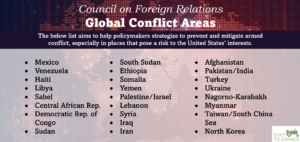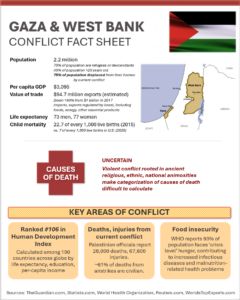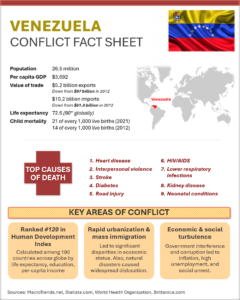Food Security: A Critical Element of Global Conflict
The Dirt
One of the constants in roughly 6,000 years of human civilization is conflict, from small, short-lived skirmishes between competing factions over matters large and small, to global conflicts costing tens of millions of lives. Our modern world is no different. But what drives human beings to take up arms and battle each other? The reasons are many. But we can’t ignore the role of food in the mix.
Global Food
Food Security: A Critical Element of Global Conflict
The Dirt
One of the constants in roughly 6,000 years of human civilization is conflict, from small, short-lived skirmishes between competing factions over matters large and small, to global conflicts costing tens of millions of lives. Our modern world is no different. But what drives human beings to take up arms and battle each other? The reasons are many. But we can’t ignore the role of food in the mix.
Psychologists tell us we all have the same instinct. When threatened, our first instinct is to flee – just get away from the problem. Walk away from the bully. Leave the bar when the debate over the “greatest quarterback of all time” gets too heated. Go to the other end of the table when that in-law starts on the all-too-familiar political rant at the family reunion dinner. (And in my family, just get out of town until the grand jury is no longer in session.)
And around the world, the issue is much more serious. For millions of people worldwide, the option has become more drastic —
Simply pack up everything you can carry and head for the border.
Recent migration trends
The United Nations in 2020 estimated there were 281 million emigrants worldwide, or roughly 3.6 percent of the entire global population. The flow of people occurs around the world – Europe, Asia, Africa, North and South America – no area is immune.
In the United States, authorities last year admitted over 820,000 migrants, up from 797,800 in the previous year. Border officials report the flow of all immigrants into the United States – euphemistically referred to as “encounters with authorities” — was more like 2.8 million, up from 2.7 million in 2022.
Immigration has been a key factor in U.S. growth and development, certainly. “Migrant stock” – meaning those living in the country now but born in another country – in 2015 was estimated at more than 46 million – or more than 14 percent of our entire population.
The United States added 1.6 million to our population last year, bringing us to 334.9 million, according to the U.S. Census Bureau. Of that increase, more than two-thirds came from international migration. With a U.S. birth rate of just 12 births per 1,000 people, migrants drive our nation’s population growth.
Conflict ignites flight…or fight
The flood of people seeking to flee their home countries attracts widespread attention.
For instance, in 2023, 1.55 million people fled Sudan to nearby countries such as Ethiopia, Egypt and Chad because of a war between the Sudanese Armed Forces and the Rapid Support Forces. Since the war began, over 6 million have fled Ukraine for parts of Europe. And so do a comparable flood of stories about armed conflict around the world. The two phenomena may have more in common than the headlines reveal.
Those same psychologists who explain our propensity for “flight” also point to another human characteristic – the “fight or flight” syndrome. What happens when it’s simply impossible to flee a bad situation? What happens when you simply can’t run to a new home, a new town, or a new country? And what are the reasons so many places around the world seem to have taken the “fight” option?
There are no easy answers to those questions.
The sheer scale of the problem is immediately daunting. The Council on Foreign Relations (CFR) currently follows more than 20 active global conflicts, spanning the entire globe, plus major lingering arenas of conflict in places like the Middle East, India and Pakistan, and large parts of Africa.

Some are long-standing territorial disputes, some the latest front in a continuing history of corruption and political instability. The specific combination of contributing factors may vary from each situation to another. However, it is possible to see some of the broad categories of causes of open conflict. Think of the situation in just a few key areas:
Open and hidden aggression
As the long-running battle in Ukraine makes clear, sometimes conflict can be triggered by outside forces – one country or outside entity intent on seizing control, economic resources, or other perceived national interests. The aggression can be an open invasion, as in the case of Ukraine, or through continuing acts of terrorism designed to produce the same results.
Many regional conflicts are rooted in a continuing pattern of terroristic acts, with proxy agents providing a thin veneer of deniability among nations. This kind of aggression usually has been bubbling for generations and maintains perpetual full employment in diplomatic circles.
The vicious circle of poverty, food security & hunger-related disease
When people can’t afford or are denied access to the nutritious food they need, their health suffers dramatically. Poor, oppressed, starving people have nothing to lose by taking up arms, especially if flight is made dangerous or impossible. The “Arab Spring” of the 2010s sprung in part from the rising cost and increasing lack of food.

The United Nations Food and Agriculture Organization (FAO) estimates that levels of malnourished populations have been rising steadily since 2014 around the world, reaching 8.9 percent of the world’s population prior to the COVID-19 pandemic. Between 2018 and 2019 alone, the number of hungry people expanded by 10 million.
The World Health Organization (WHO) estimates the ranks of the global malnourished have increased by over 150 million since then. If people will take up arms over a tank of gasoline, imagine what they will do to ensure food for their families.
The incidence of natural disasters
Floods, drought, high temperatures, hurricanes and typhoons, earthquakes – all destroy homes, communities, and lives. But some catastrophes can also fuel food insecurity or social unrest, destroying local agricultural productivity and the food supply chain.
Significant damage to the natural resource base can be a strong influence on the willingness of people to relocate – or to fight for those resources possessed by others. The conflict may be between nations, or within one, as the situation in Somalia has made clear. Civil war can be just as vicious as international conflict.
Breakdown in social order & institutions
Modern society is rooted in the presence of certain basic institutions and systems: efficient and effective government administration, a fair and impartial legal system, a stable financial system, some form of functioning, transparent market system to establish prices and value, and fundamental human services such as safe water, power and personal protection.
Criminality and especially criminal violence must be controlled. When any of those critical elements of society fail or are called into question, the foundation of social stability is threatened. When corruption and incompetence reach critical levels, strikes, street demonstrations, political resistance –and conflict – become increasingly appealing options – and the source of many civil wars plaguing nations on the CFR list.
Taking a closer look
Ask Venezuela for details, if you want – or any country plagued by government failure to protect its citizens and internal terrorist attacks. You can learn more about Venezuela’s conflict-ridden system below; Somalia and Gaza & West Bank are also listed to serve as tragic examples of designated conflict areas, too.
The Bottom Line
Conflict within the global community of nations has many causes. But we can’t underestimate the power of food security in triggering much of the destruction and suffering that come from open warfare, acts of terrorism, government's failure to govern, natural disasters, and social discord. If peacemakers really want to cool down the embers of conflict that burn around the world, an excellent starting point may be to fight for a global food system in which governments makes safe, nutritious, and affordable food available to as many people as humanly possible. It may not be the complete answer to universal peace, but well-fed, healthy people might be a lot less inclined to seek a better life through migration or war.

One Big Beautiful Bill for Dummies
So now that most of the political clamor has died down, what are the facts behind the Big Beautiful Bill for food producers and consumers? We burrowed through the nearly 900 pages of legislative language to find the key provisions – and found some interesting details behind the headlines and hoopla.









